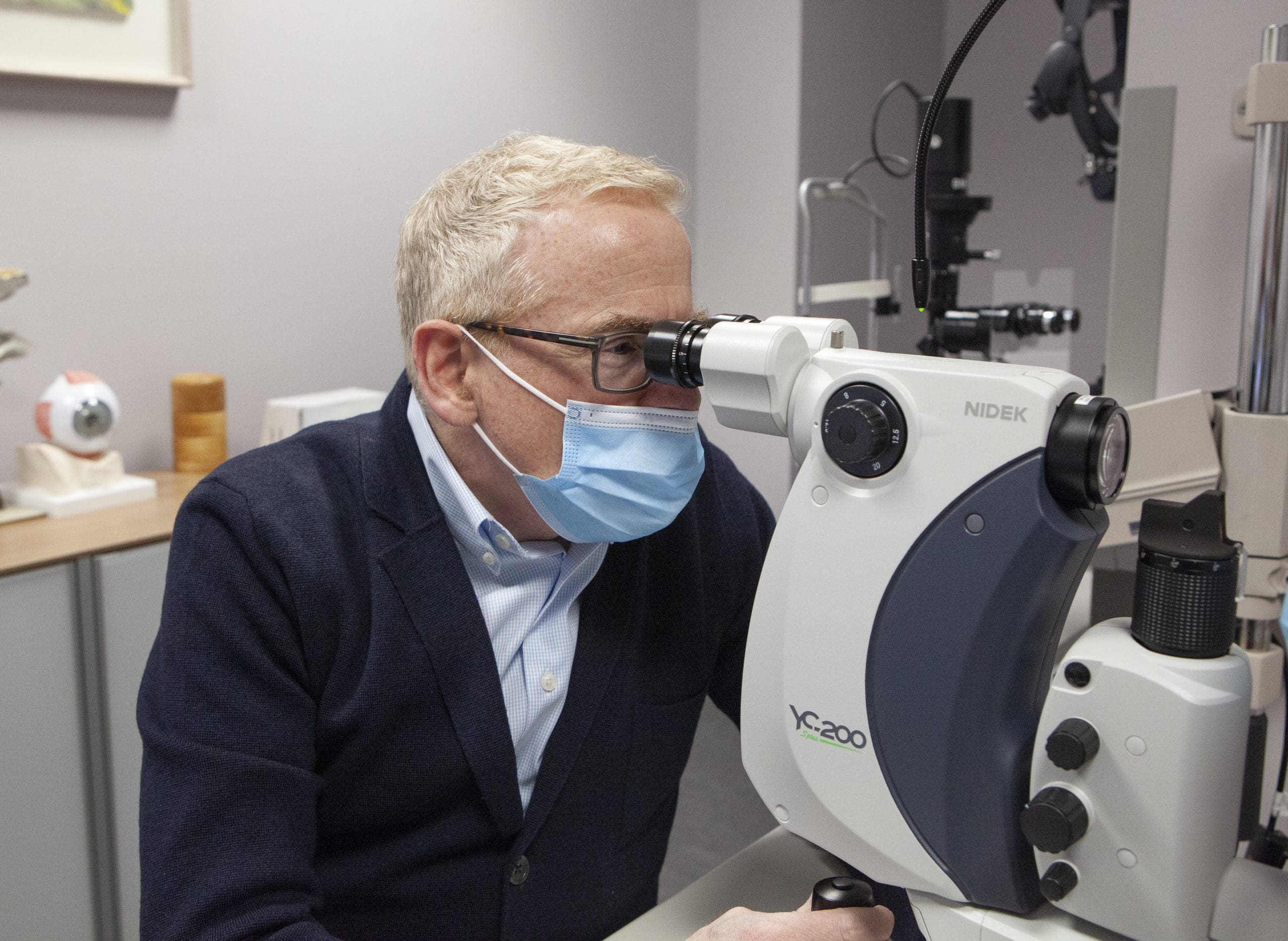How does Argon laser treatment work?
During the treatment a laser beam is focused on the back of the eye. This beam of light is absorbed by the retinal pigment under the retina. The light power can be varied to do different things. A lower light power can thin the retinal pigment to allow oxygen to come from a deeper layer called the choroid or a higher light power can be used to bond the retina to the retinal pigment layer.

What eye conditions can be treated by Argon grid laser
- Macular oedema – Grid laser
This is swelling of the centre of the retina (or macula) most often due to diabetes or a retinal vein occlusion. This form of laser applies a small grid pattern of laser to thin the retinal pigment allowing oxygen to come from the deeper choroid layer.
- Proliferative retinopathy – Pan-retinal photocoagulation
This is where new blood vessels grow on the surface of the retina as a response to retinal blood flow reduction most often due to diabetic retinopathy or a retinal vein occlusion. This form of laser applies a pattern of laser over a wide area of the peripheral retina to thin the retinal pigment allowing oxygen to come from the deeper choroidal layer. If the oxygen levels increase enough the new blood vessels on the retina will stop growing
- Retinal Break – Retinopexy
A break in the retina happens when the natural jelly in the eye, the vitreous, moves and pulls on the retina. The break can be a hole, a tear or a dialysis depending on how the jelly movement has changed the retina. This form of laser is applied around the break to bond the retina to the underlying retinal pigment to prevent the retina detaching from the eye wall.
How is the treatment done?
Grid laser is always done with a contact lens.
Pan-retinal photocoagulation or Retinopexy can be done with a contact lens or with an indirect laser. The decision on which way either of these treatments is done depends on how light sensitive you are and how much treatment is needed.
With a contact lens:
Your eye will be dilated before the procedure and you will have local anaesthetic drops put onto the eye to numb it so you won’t feel pain.
You will be asked to sit in front of the laser machine and to place your chin and forehead on to the rests.
Your eye doctor will place a small contact lens on the front surface of the eye. This allows the doctor to view the eye and to direct the laser beam into the eye. This also prevents you from blinking during the treatment.
With an indirect laser:
This is done in an operating room as a daycase procedure
Your eye will be dilated before the procedure
In the operating room you will either have an injection of local anaesthetic around your eye or you will have a general anaesthetic.
FAQ's
- Argon laser with a contact lens
The laser treatment itself will take about 20 minutes but your visit to the clinic will last about an hour. Immediately after the laser treatment, the contact lens is removed and you are allowed to go home. It would be helpful if someone can come with you to help you home. Normal activities can be resumed after four to six hours.
- Argon laser with an indirect laser
Your day ward visit will take about 3 to 4 hours and you need to fast for 6 hours before your appointment time. Someone will have to come to the hospital to help you home. You may be asked to restrict your activities including reading for about 5 days if you have had treatment for a retinal break.
Painkillers are not usually required but if they are over the counter painkillers such as paracetamol are usually enough. You will be on a reducing dose of anti-inflammatory eye drops for 9 days.
A follow up appointment will be arranged for a few weeks time. Laser treatment is aimed at saving vision. Sometimes the treatment needs to be repeated
The procedure is generally safe and effective.
As with any surgery, there are risks with Argon laser. In some cases, the surgery may not sufficiently treat the underlying condition even if done properly.
Here are some of the most common and serious risks:
- Failure to reduce macular oedema, new blood vessels on the retina or close retinal breaks with the need for additional treatments, including further laser, eye injections or surgery. Even when effective, it typically takes several weeks to see the effect of this laser and determine if further treatment is needed.
- You may have an increase in eye pressure or inflammation shortly after the procedure. You will need to use a reducing dose of anti-inflammatory drops for 9 days. You should continue any drops that you typically take for eye pressure or glaucoma.
- Although rare and unusual, there may be bleeding with the eye, a corneal abrasion, cataract, or increase in the pressure in the eye requiring different and more extensive treatment. Other risks include loss of vision, pain, irritation, or discomfort in or around the eye.
If you are concerned in any way after your treatment, please contact Progressive Vision on 01 213 5652.
If outside of office hours, please contact the Emergency Department of the Royal Victoria Eye and Ear Hospital on 01 664 4600.